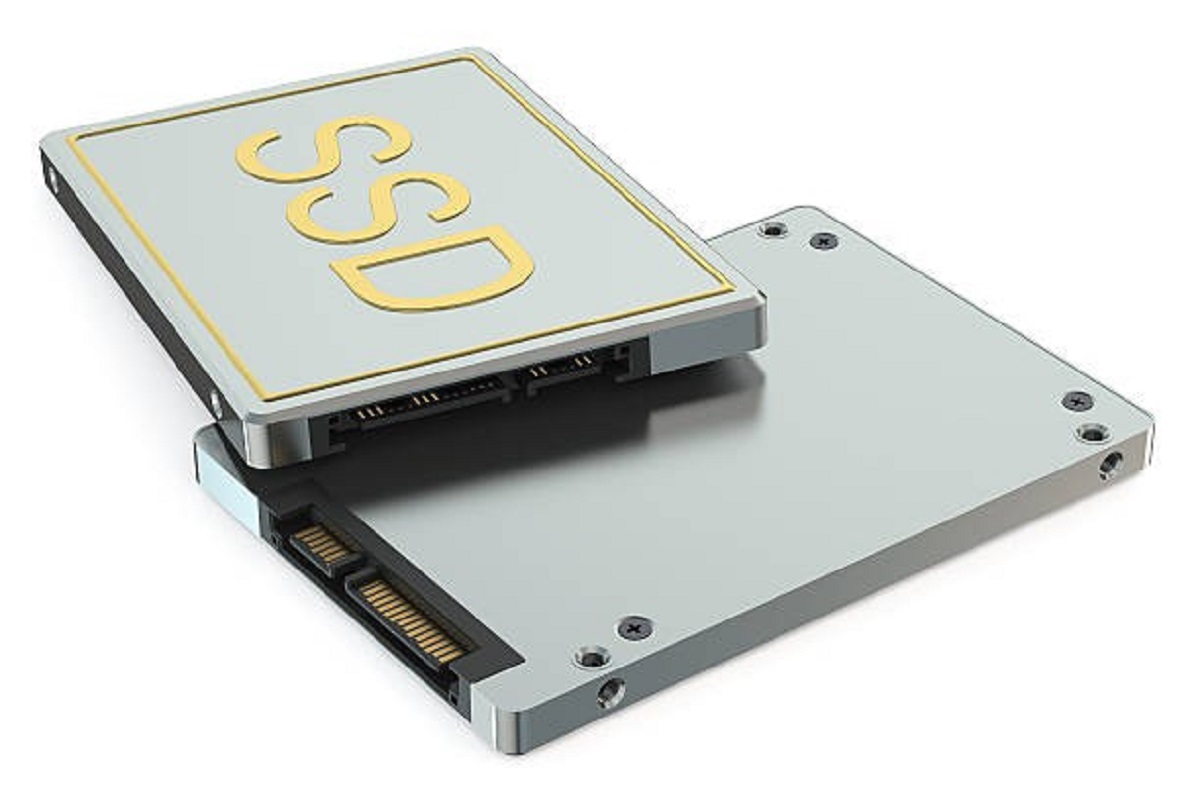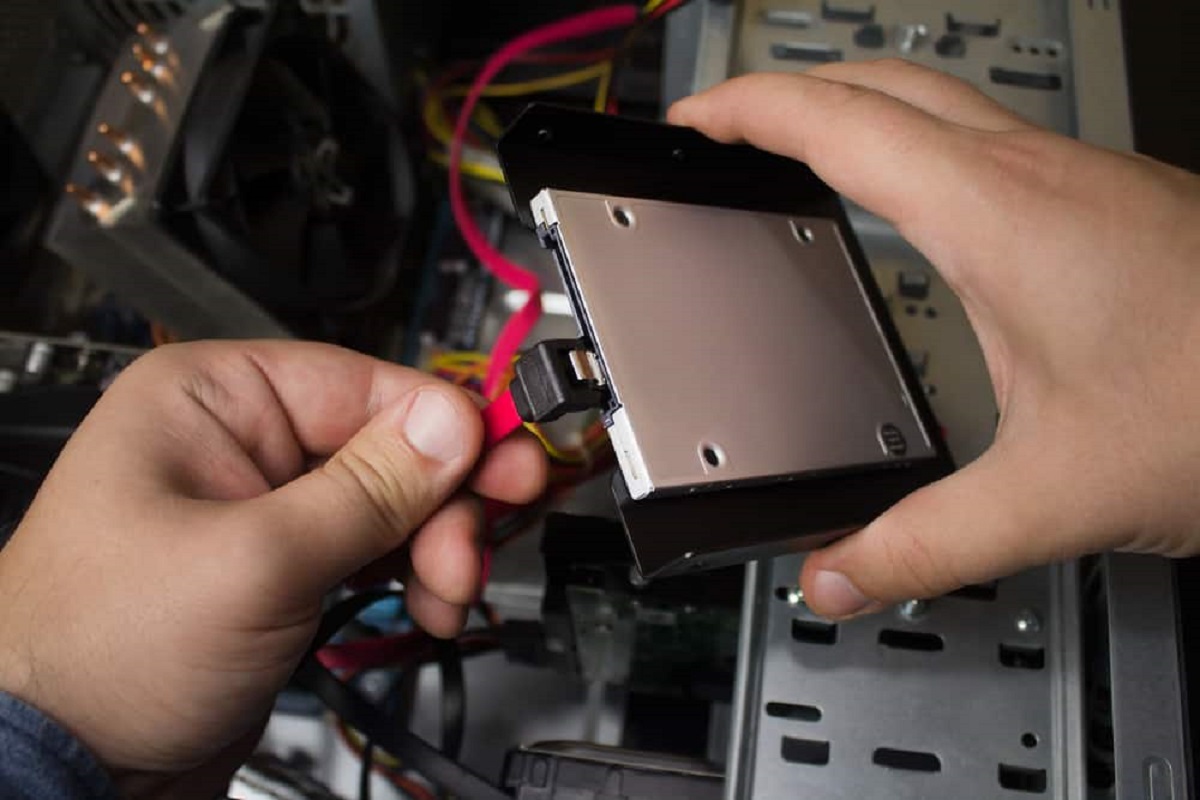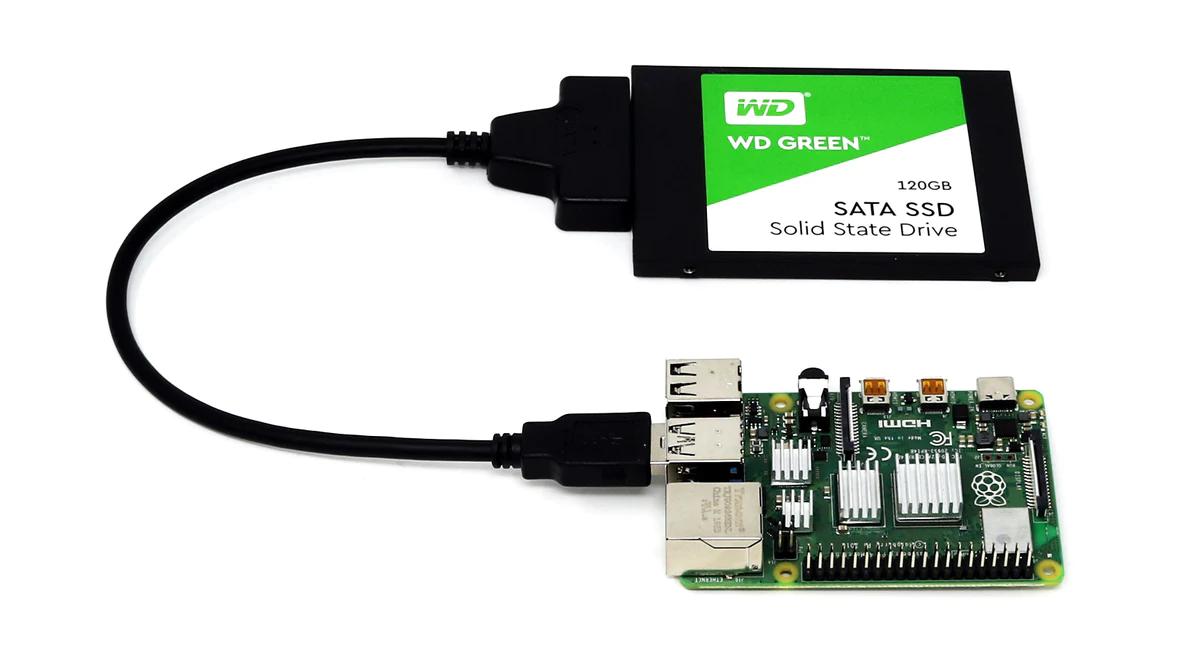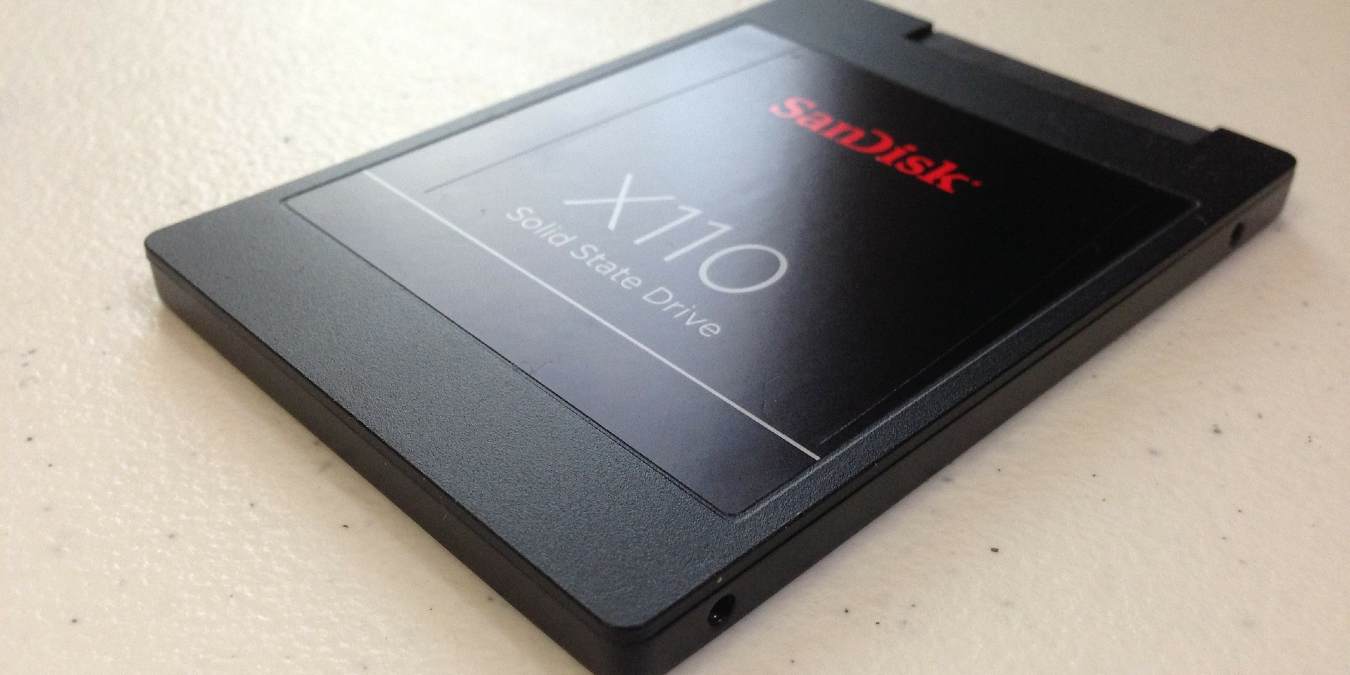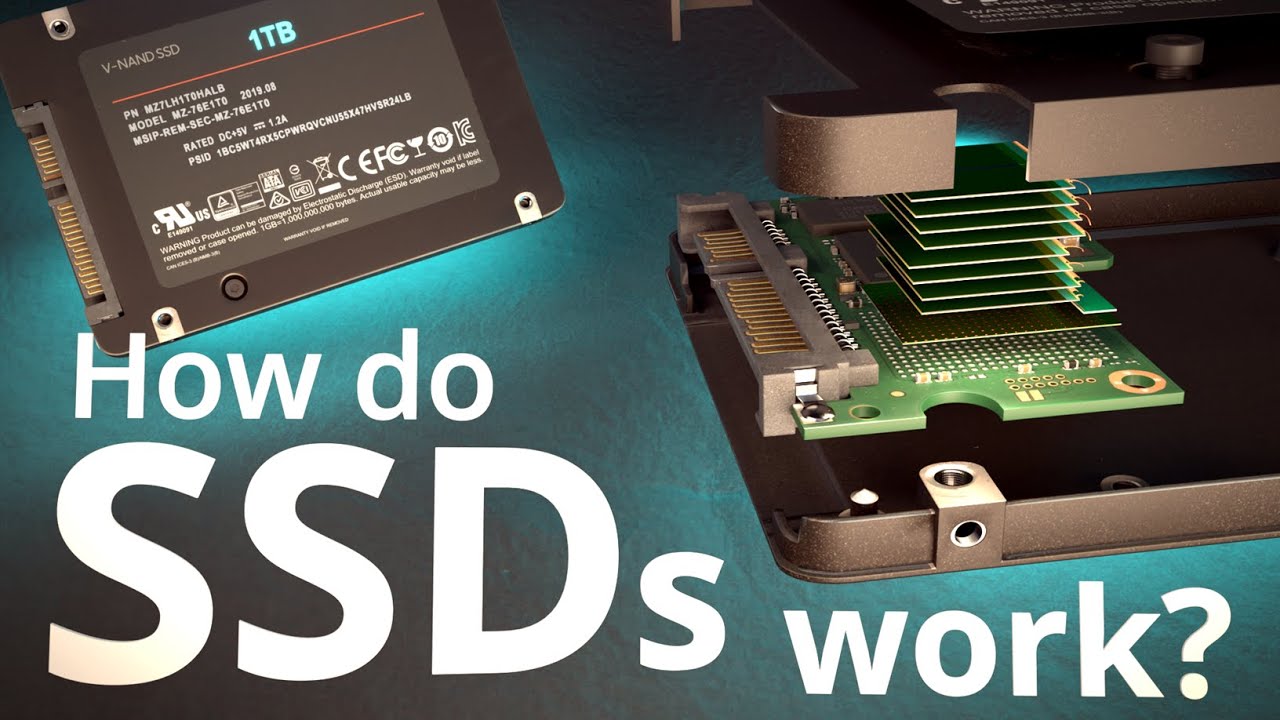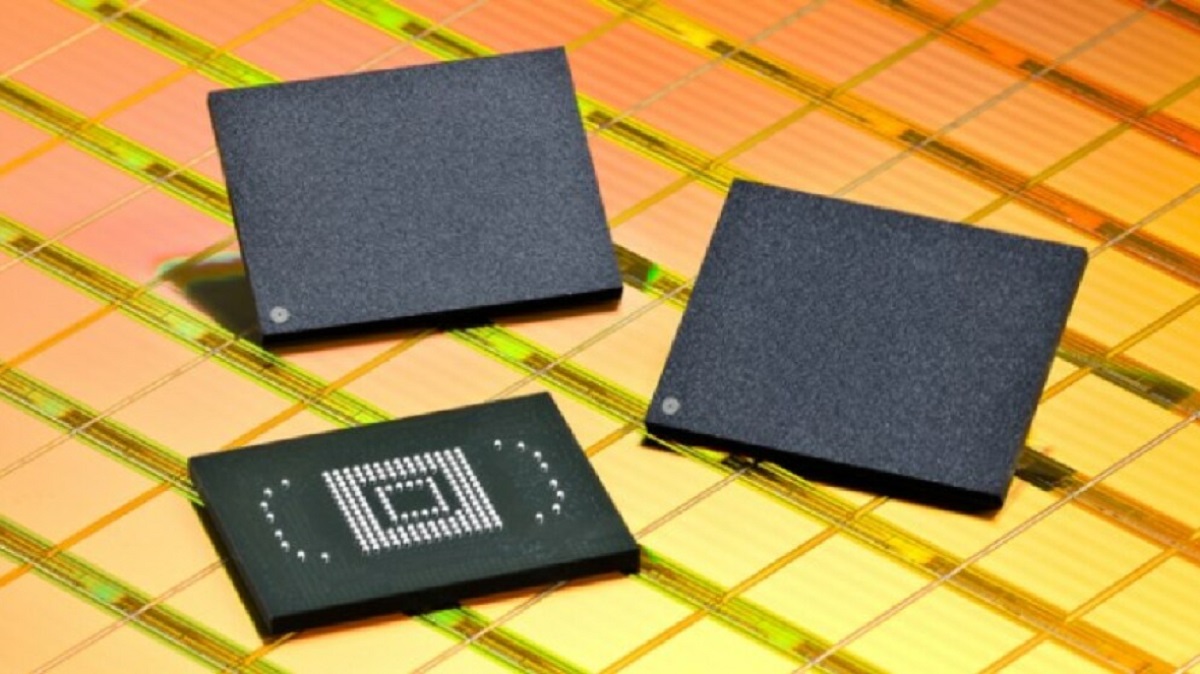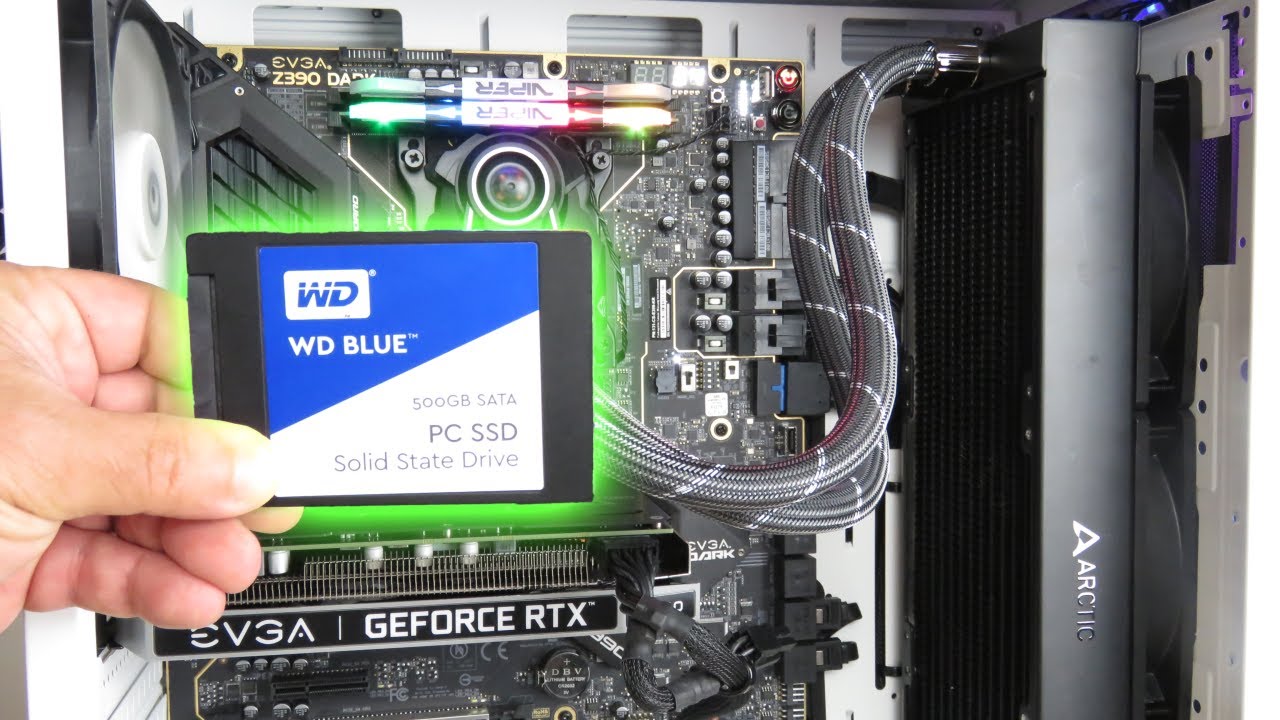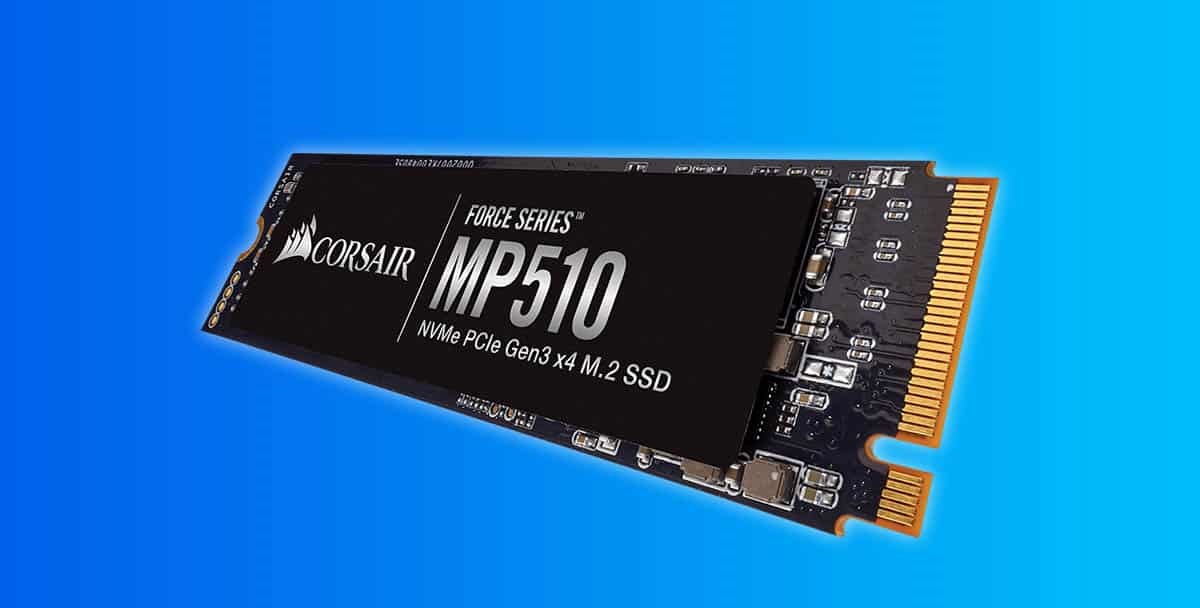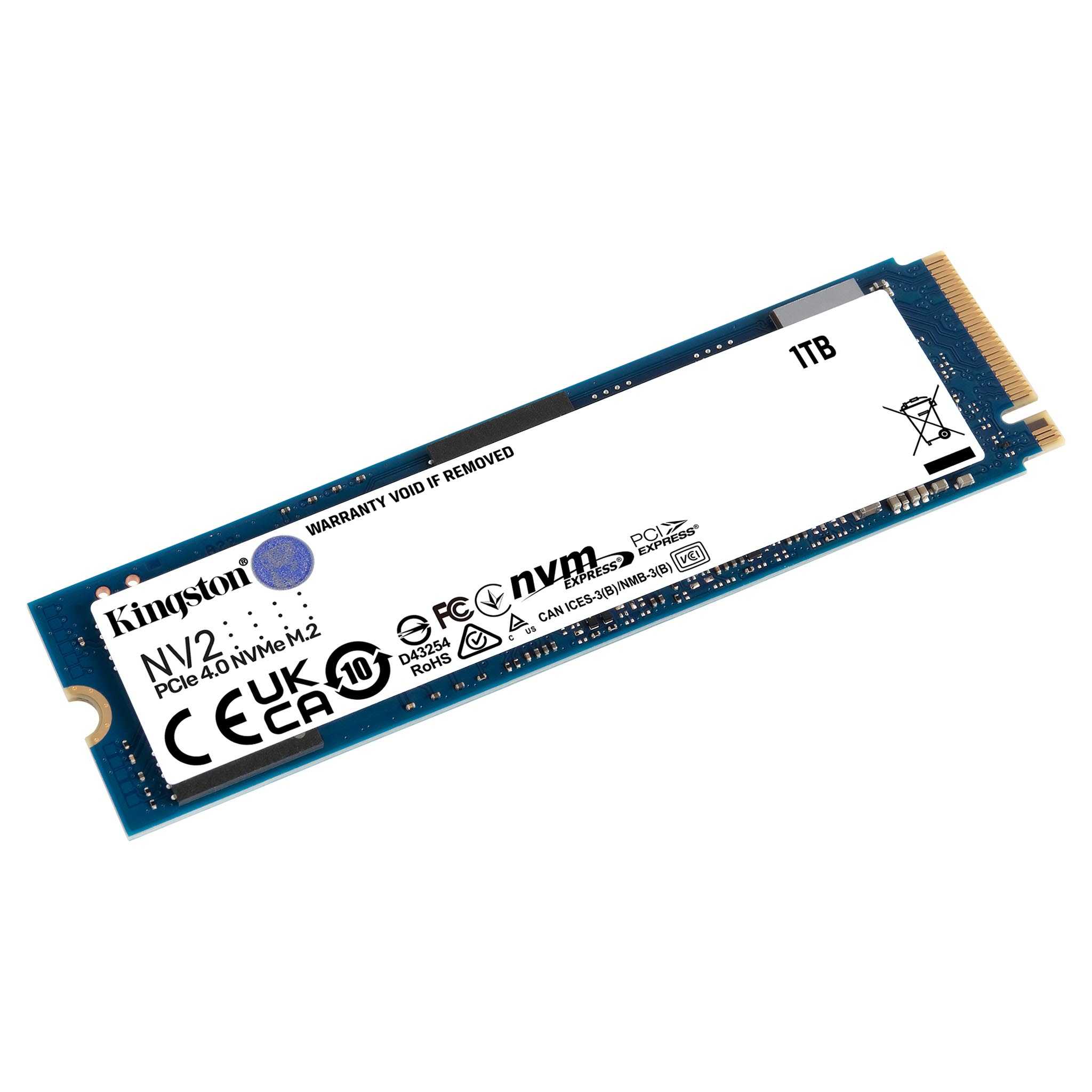Introduction
An SSD, or solid-state drive, is a type of storage device that offers significant advantages over traditional hard disk drives (HDDs). While HDDs rely on spinning magnetic disks and moving parts to store and retrieve data, SSDs use flash memory technology, allowing for faster access speeds, improved durability, and enhanced performance overall.
In recent years, SSDs have gained immense popularity due to their ability to deliver high-speed data transfer rates, reduced power consumption, and compact form factors. These features make SSDs ideal for use in a wide range of devices, including laptops, desktop computers, servers, and even some mobile devices.
Unlike HDDs, which store data magnetically on spinning platters, SSDs use NAND flash memory to store and retrieve data electronically. This means that SSDs have no moving parts, reducing the risk of mechanical failure and significantly increasing their lifespan.
This article will provide an in-depth understanding of how SSDs store data, covering the basics of NAND flash memory technology, data organization within SSDs, the process of writing and reading data, as well as an overview of key features such as garbage collection, wear leveling, and the TRIM command.
By the end of this article, you will have a comprehensive knowledge of how SSDs work, enabling you to make informed decisions when selecting and using SSDs.
Overview of SSDs
Solid-state drives (SSDs) are a type of non-volatile storage device that have become increasingly popular in recent years. Unlike traditional hard disk drives (HDDs) that use spinning magnetic disks, SSDs utilize NAND flash memory technology to store data. This difference in technology offers several advantages, including faster access speeds, improved durability, and lower power consumption.
One of the key benefits of SSDs is their incredible speed. They can read and write data at much higher rates compared to HDDs, resulting in faster boot times, quicker file transfers, and snappier overall system performance. This makes SSDs particularly valuable for tasks that require a high degree of data processing, such as gaming, video editing, and large-scale data analysis.
Another significant advantage of SSDs is their durability. Since SSDs have no moving parts, they are more resistant to physical shock and vibration compared to HDDs. This makes them well-suited for portable devices like laptops, where data integrity can be compromised by frequent movement. Additionally, the lack of moving parts reduces the likelihood of mechanical failure, resulting in a longer lifespan for SSDs.
SSDs also consume less power compared to HDDs, making them more energy-efficient. This can lead to increased battery life in laptops and reduced electricity costs for data centers and server farms. Furthermore, the absence of mechanical components means that SSDs generate less heat during operation, resulting in a cooler and quieter computing experience.
Form factor is another notable aspect of SSDs. They come in a variety of sizes, including the standard 2.5-inch drives that can easily be installed in desktop computers and laptops. In addition, smaller form factors such as M.2 and PCIe SSDs are becoming increasingly popular for use in ultra-thin laptops and compact devices.
While SSDs offer numerous advantages over HDDs, they do have some limitations as well. The main drawback is their higher cost per gigabyte compared to HDDs. However, the continuous advancements in flash memory technology and increased production volumes are gradually driving down the prices of SSDs, making them more accessible to consumers.
Overall, SSDs provide a compelling alternative to traditional HDDs, offering faster performance, improved durability, lower power consumption, and a wide range of form factors. As SSD technology continues to evolve, we can expect even greater advancements in speed, capacity, and affordability, making them an increasingly attractive choice for both personal and professional use.
Basics of Storing Data in SSDs
At the core of solid-state drives (SSDs) is the use of NAND flash memory to store and retrieve data. Understanding the basics of how data is stored in SSDs will help us appreciate the inner workings of these high-performance storage devices.
NAND flash memory is a type of non-volatile memory that retains data even when power is removed. It is organized into a grid-like structure consisting of individual memory cells. Each memory cell can store multiple bits of information, commonly referred to as multi-level cell (MLC) or triple-level cell (TLC) technology.
The most fundamental unit of storage in an SSD is the memory cell. Each memory cell can be in one of two states: programmed (representing a logical “1”) or erased (representing a logical “0”). The state of the memory cell is determined by the presence or absence of a charge in the transistor that controls it.
To write data to an SSD, the controller sends an electrical charge to the selected memory cells, programming them with the desired values. The data is then stored as a series of electrical charges in the floating gate of the memory cells. This process, known as “programming,” alters the state of the memory cells to represent the binary data.
Reading data from an SSD involves the opposite process. The controller measures the electrical charges in the memory cells and interprets them as binary data. By reading the states of the memory cells, the controller can retrieve the stored data.
To efficiently organize and access data, SSDs employ a hierarchical structure. At the highest level, data is organized into blocks, which are further divided into pages. Each page consists of a fixed number of bytes, usually 4KB or 8KB in size. Within each page, individual sectors are used to store the actual user data.
Writing data to an SSD is a more complex process compared to reading data. When new data needs to be written, the controller first identifies a block that contains free and erased pages. It then performs an erase operation on the entire block, clearing all the previous data. After erasing, the controller writes the new data to the empty pages within the block.
However, over time, as the SSD is used and filled with data, some pages may become partially or fully filled with outdated information. This results in a phenomenon known as “write amplification,” where the controller needs to perform additional operations to manage the data and maintain performance.
To mitigate write amplification and optimize performance, SSDs employ various techniques. These include garbage collection, which reclaims space by erasing blocks with invalidated or stale data, and wear leveling, which distributes write operations evenly across the memory cells to prevent excessive wear on specific blocks.
By understanding the basics of storing data in SSDs, we gain insight into the complexities involved in writing and reading data from these advanced storage devices. The next sections will delve deeper into specific mechanisms and features employed by SSDs to optimize performance and ensure data integrity.
NAND Flash Memory
When it comes to storing data in solid-state drives (SSDs), NAND flash memory plays a vital role. NAND flash memory is a type of non-volatile, electrically erasable programmable read-only memory (EEPROM) that has revolutionized the storage industry.
NAND flash memory gets its name from the “NOT AND” gates used in its structure. These gates are responsible for the ability to erase blocks of data electronically, making NAND flash memory highly flexible and efficient.
One of the key advantages of NAND flash memory is its non-volatility. Unlike volatile memory, such as random access memory (RAM), NAND flash retains its stored information even when power is removed. This makes it ideal for storage devices like SSDs, where maintaining data integrity is crucial.
NAND flash memory consists of a series of memory cells organized in a grid-like structure. Each memory cell stores a certain number of bits, which can range from a single bit (single-level cell or SLC) to multiple bits (multi-level cell or MLC). The most common type of NAND flash memory used in consumer-grade SSDs today is MLC, which can store two or more bits per cell.
Within each cell, an insulated floating gate is used to hold an electrical charge, representing the value of the stored data. The presence or absence of this charge determines the binary state of the memory cell. Applying voltage to the control gate affects the flow of electrons, allowing for programming or erasing of the memory cell.
Programming a memory cell involves injecting electrons into the floating gate, storing a charge that represents a logical “1.” Erasing a cell, on the other hand, involves removing the charge from the floating gate, resetting the memory cell to a logical “0.” The ability to electronically write and erase data allows for fast and efficient operations in NAND flash memory.
However, NAND flash memory does have a limited lifespan. Each time a memory cell is programmed or erased, it undergoes a wear-out process that gradually reduces its ability to retain a charge. This wear-out process is characterized by the concept of “program-erase cycles,” or P/E cycles.
The number of program-erase cycles that a NAND flash memory cell can endure varies depending on the type of flash memory used. SLC flash memory typically has the highest endurance, with tens of thousands of P/E cycles. MLC flash memory offers lower endurance, while newer technologies, such as TLC (triple-level cell) and QLC (quad-level cell) flash memory, sacrifice endurance for increased storage capacity.
Overall, NAND flash memory is a crucial component in SSDs, providing non-volatile storage with high-performance characteristics. Advancements in NAND flash technology continue to drive improvements in SSD capacities, speeds, and reliability, making them an increasingly popular and viable storage solution for a wide range of applications.
NAND Flash Cells
Central to the functioning of NAND flash memory are the individual memory cells that make up the storage structure. NAND flash cells are the building blocks of this technology, responsible for storing and retrieving data electronically.
Each NAND flash cell is composed of a transistor and a floating gate. The transistor acts as a control gate, regulating the flow of electrons to and from the floating gate. The state of the flash cell is determined by the presence or absence of electrical charges on the floating gate.
The most basic type of NAND flash cell is the single-level cell (SLC), which can store one bit of information. An SLC flash cell has two possible states: programmed and erased. A programmed cell has a charge or electrons trapped on the floating gate, representing a logical “1.” Alternatively, an erased cell has no charge on the floating gate, representing a logical “0.”
To achieve higher storage densities, multi-level cell (MLC) NAND flash cells were introduced. MLC flash cells can store multiple bits of information, typically two or more bits per cell. This is achieved by dividing the voltage level ranges across the floating gate into smaller increments, each representing a different combination of bits.
For example, a typical MLC flash cell can have four voltage levels, each representing two bits of data. The specific voltage level on the floating gate determines the combination of bits stored in the cell. However, packing more bits into each cell comes at the cost of reduced endurance and increased vulnerability to errors.
In addition to MLC, there are also triple-level cell (TLC) and quad-level cell (QLC) NAND flash cells. As the names suggest, TLC cells can store three bits per cell, while QLC cells can store four bits per cell. These higher-density cells provide manufacturers with the ability to produce SSDs with larger capacities at a lower cost per gigabyte, but they have lower endurance and slower write speeds compared to SLC and MLC cells.
It is important to note that as the number of bits per cell increases, the difficulty of accurately discerning between voltage levels also increases. This results in a greater chance of errors during reading and writing operations, requiring more advanced error correction techniques to maintain data integrity.
Despite their differences in storage capacity and performance characteristics, NAND flash cells in SSDs all operate on the same principle of electrical charges on the floating gate. Whether it’s SLC, MLC, TLC, or QLC, these cells collectively form the foundation of NAND flash memory, enabling the high-speed, non-volatile storage capabilities that have revolutionized the storage industry.
Memory Cells in SSDs
In solid-state drives (SSDs), memory cells are the fundamental units responsible for storing and retrieving data. These cells, typically composed of NAND flash memory, play a crucial role in the performance and functionality of SSDs.
In an SSD, memory cells are organized in a grid-like structure, forming a dense array. Each memory cell has the ability to store multiple bits of data, allowing for higher storage capacities within a compact form factor.
The operation of memory cells in SSDs is based on the principles of binary logic. The most common types of memory cells used in SSDs are single-level cell (SLC), multi-level cell (MLC), triple-level cell (TLC), and quad-level cell (QLC).
SLC memory cells can store a single bit of information, represented by either a logical “1” or “0.” These cells provide higher endurance and faster performance compared to cells with higher bit densities. Due to their simplicity and reliability, SLC cells are often used in applications that require high reliability and durability.
MLC memory cells, on the other hand, can store two or more bits of data per cell. This increased storage density comes at the cost of reduced endurance and slower write speeds. MLC cells are commonly used in consumer-grade SSDs that prioritize cost-effectiveness and moderate performance.
TLC memory cells take density a step further by storing three bits of data per cell. The increased bit density in TLC cells allows for even greater storage capacities, but at the expense of endurance and write speeds. TLC cells are commonly found in mainstream consumer SSDs where cost-per-gigabyte and capacity are primary considerations.
QLC memory cells are the latest advancement in NAND flash technology, capable of storing four bits of data per cell. While offering even higher storage densities, QLC cells exhibit lower endurance and slower write speeds compared to other cell types. QLC cells are commonly used in entry-level SSDs and consumer storage devices with a focus on cost-effective, high-capacity solutions.
It is important to note that the higher the density of memory cells, the more complex data processing becomes. The inherent challenges in accurately storing and retrieving multiple bits in a single cell require advanced error correction techniques to ensure data integrity.
In order to maximize performance and lifespan, SSD controllers effectively manage the allocation of data across the memory cells. Wear leveling algorithms distribute write operations evenly across the cells, preventing excessive wear on specific cells and ensuring a more balanced usage of the entire storage array.
Memory cells are the building blocks of SSDs, enabling fast, reliable, and high-capacity storage. Advances in memory cell technology continue to drive innovation in the SSD market, offering users increasingly efficient, durable, and affordable storage solutions.
Data Organization in SSDs
Efficient data organization is a key aspect of solid-state drives (SSDs) that contributes to their high performance and reliability. In SSDs, data is organized into a hierarchical structure comprising blocks, pages, and sectors.
At the highest level of organization, SSDs are divided into blocks. A block is a fixed-sized unit of storage that contains multiple pages. The size of a block can vary depending on the SSD model but is typically around 128KB or 256KB.
Each block is further divided into pages, which are the smallest individually erasable units within an SSD. Pages are typically 4KB or 8KB in size, although larger sizes are also used. Pages are where the actual data is stored.
Within each page, the data is organized into sectors, which represent the smallest addressable units. A sector is usually 512 bytes in size and is the unit that the operating system interacts with when reading or writing data to the SSD.
When writing data to an SSD, the controller typically writes data at the sector level. However, due to the physical characteristics of NAND flash memory, modifying data at the sector level can be inefficient. Instead, SSDs employ a technique known as “program/erase” (P/E) cycles to manage data.
During a write operation, if only a small portion of a page needs to be modified, the controller must first read the entire page into an internal cache, update the data in the cache, and then write the entire modified page back to a new location in the SSD. This process is known as read-modify-write, or program/erase cycles (P/E cycles).
Over time, as data is written and modified, some blocks within an SSD may become partially filled with valid data and partially filled with invalidated or deleted data. This can lead to a phenomenon known as write amplification, where the SSD performs additional read, modify, and write operations to manage the data and maintain performance.
To combat write amplification, SSDs employ various techniques such as garbage collection and wear leveling. Garbage collection involves erasing blocks that contain outdated or invalidated data, reclaiming the space and making it available for new data to be written. Wear leveling ensures that write operations are evenly distributed across the SSD to prevent certain blocks from wearing out prematurely.
SSDs also make use of advanced algorithms and data management techniques to optimize performance. These include compression and deduplication, which reduce the amount of data that needs to be written to the SSD, improving both the lifespan and overall performance of the drive.
Efficient data organization in SSDs is a critical component for maintaining performance, maximizing lifespan, and ensuring data integrity. By intelligently managing data at the block, page, and sector level, SSDs offer high-speed, reliable, and efficient storage solutions for a wide range of applications.
Blocks, Pages, and Sectors
Blocks, pages, and sectors are essential components in the data organization structure of solid-state drives (SSDs). Understanding how these elements work together is crucial to comprehending the underlying technology and efficiency of SSDs.
An SSD is divided into blocks, which are fixed-sized storage units. Each block typically contains a set number of pages. The size of a block can vary depending on the SSD, but common sizes range from 128KB to 256KB.
Pages are the smallest individually erasable units within an SSD. These represent the actual storage space for data. Common page sizes are 4KB or 8KB, although larger sizes are also used in some SSD models.
Sectors, on the other hand, are smaller units of data organization within pages. A sector typically occupies 512 bytes of space. It is the unit that the operating system interacts with when reading from or writing to an SSD.
When data is written to an SSD, it is typically done at the sector level. However, due to the nature of NAND flash memory, modifying data at the sector level can be inefficient. Instead, SSDs employ a technique known as program/erase (P/E) cycles to manage data.
During a write operation, if only a portion of a page needs to be modified, the SSD controller employs a process called read-modify-write. It involves reading the entire page into an internal cache, updating the data in the cache, and then writing the modified page back to a new location in the SSD.
Over time, as data is written, modified, and deleted, blocks may become partially filled with both valid and invalidated data. This leads to a phenomenon known as write amplification, where additional read, modify, and write operations are required to manage the data and maintain SSD performance.
To optimize performance and prevent premature wear, SSDs implement mechanisms like garbage collection and wear leveling. Garbage collection involves locating blocks that contain invalidated or deleted data and erasing them to make space available for new data. Wear leveling ensures that write operations are evenly distributed across the SSD to prevent specific blocks from wearing out faster than others.
Data organization at the block, page, and sector level plays a crucial role in achieving high-speed, efficient, and reliable storage in SSDs. By intelligently managing data at different levels, SSDs can provide exceptional performance while ensuring data integrity and maximizing the lifespan of the drive.
Writing Data to SSDs
The process of writing data to solid-state drives (SSDs) involves several steps to ensure efficient storage and retrieval. Understanding how data is written to an SSD is crucial for optimizing performance and maximizing the lifespan of the drive.
When data needs to be written to an SSD, the controller first determines an available block with erased pages to store the new data. The process begins with an erase operation on the selected block, which clears the existing data from the block and prepares it for new data storage.
Once the block is erased, the controller can begin writing the data. It is important to note that SSDs write data at the page level. Instead of directly modifying a specific sector, as in traditional HDDs, SSDs write or update a whole page at a time.
Writing to an SSD involves transferring the data from the host system to the SSD’s internal cache memory. From there, the controller manages the allocation and distribution of data to the appropriate pages within the selected block.
It’s worth mentioning that the write process on an SSD involves program/erase (P/E) cycles. To modify data within a page, the controller performs a read-modify-write operation. It reads the entire page into the cache, modifies the data in the cache, and writes the entire modified page back to a new location in the SSD.
Write amplification can occur during this process, as multiple pages may need to be read, modified, and written due to partial updates. Garbage collection plays a vital role in minimizing write amplification by reclaiming blocks with invalidated or deleted data, consolidating fragmented space, and ensuring efficient utilization of the SSD’s storage capacity.
Another important aspect of writing data to SSDs is the concept of “wear leveling.” SSDs distribute write operations across the available blocks to prevent excessive wear on specific blocks. By evenly distributing the write load, wear leveling ensures that all blocks within the SSD wear out at a similar rate, optimizing the drive’s overall lifespan.
It is worth noting that modern operating systems support the TRIM command, which informs the SSD controller about areas of deleted data, allowing the controller to proactively optimize performance and efficiency by clearing blocks with stale or invalidated data.
Overall, writing data to an SSD involves erasing blocks, allocating new pages, and managing data at the page level. Understanding the intricacies of this process allows users to make informed decisions regarding their data storage systems, optimizing performance, and maintaining the longevity of their SSDs.
NAND Flash Write Cycles
In solid-state drives (SSDs) that utilize NAND flash memory, the concept of write cycles is an important factor to consider. NAND flash memory has a limited number of program/erase (P/E) cycles, which affects the overall lifespan and durability of SSDs.
Program/erase cycles refer to the process of programming data into the memory cells and subsequently erasing them when the data needs to be modified or removed. Each time a memory cell undergoes a complete program and erase cycle, it gradually wears out, leading to potential data loss or corruption.
SLC (single-level cell) NAND flash memory generally offers the highest endurance among its counterparts. It can typically withstand tens of thousands of P/E cycles before experiencing wear-out issues. This makes SLC NAND flash well-suited for applications that demand high reliability and durability, such as industrial or enterprise storage systems.
MLC (multi-level cell) NAND flash, which can store multiple bits per cell, has a lower endurance compared to SLC. MLC flash cells can typically handle several thousand P/E cycles before reaching their wear-out point. While MLC has reduced endurance, its lower cost makes it a popular choice for consumer-grade SSDs.
TLC (triple-level cell) NAND flash offers higher storage capacity and lower production costs than MLC flash, but at the expense of even lower endurance. TLC flash cells endure even fewer P/E cycles, generally in the range of hundreds or low thousands. TLC NAND flash is commonly used in consumer SSDs where cost-per-gigabyte and capacity are the primary considerations.
QLC (quad-level cell) NAND flash, the latest development in flash memory technology, offers the highest storage capacities but also exhibits the lowest endurance. QLC cells store four bits of information per cell but have the shortest lifespan, typically ranging from tens to a few hundred P/E cycles.
It is important to note that various mechanisms, such as wear leveling and error correction codes, are implemented in SSD controllers to extend the lifespan and maintain the reliability of NAND flash memory. Wear leveling helps evenly distribute write operations across the memory cells, preventing specific cells from wearing out prematurely.
Error correction codes (ECC) are algorithms that detect and correct potential errors that may occur during the read and write operations. ECC methods used in SSDs can significantly improve data integrity and ensure reliable storage, compensating for the inherent limitations of NAND flash memory.
Optimizing the usage of an SSD by minimizing unnecessary writes can also help prolong its lifespan. Techniques such as reducing unnecessary file operations, enabling operating system features like TRIM, and disabling excessive virtual memory can minimize the number of write operations performed on the SSD.
Understanding the write cycle limitations of NAND flash memory allows users to make informed decisions when selecting an SSD based on their specific needs, balancing endurance, performance, and cost considerations.
Garbage Collection and Wear Leveling
Garbage collection and wear leveling are essential techniques implemented in solid-state drives (SSDs) to optimize performance, enhance data integrity, and prolong the overall lifespan of the drive.
Garbage collection is a process by which an SSD reclaims blocks that contain invalidated or deleted data. As data is written and deleted from an SSD, blocks may become partially filled with both valid and stale data. These blocks need to be cleared before new data can be written to them. Garbage collection ensures efficient utilization of the SSD’s storage capacity by reclaiming freed-up space and consolidating the available empty blocks.
The garbage collection process typically occurs in the background during idle periods or low activity, minimizing any impact on real-time performance. By reclaiming blocks and freeing up space, garbage collection prevents performance degradation due to the limited availability of empty blocks for new data storage.
Wear leveling is another critical mechanism employed in SSDs to distribute write operations evenly across the available blocks. Through wear leveling, SSDs aim to prevent specific blocks from wearing out prematurely due to excessive write operations. By evenly distributing write activity across the storage medium, wear leveling ensures that all blocks within the SSD endure a similar amount of wear, effectively extending the overall lifespan of the drive.
Wear leveling is accomplished by dynamically mapping logical addresses (such as file system addresses) to physical locations within the SSD. When data is written to the drive, the SSD controller intelligently assigns the data to different physical blocks, rotating the write operations throughout the entire storage medium. This ensures that no single block is repeatedly subjected to excessive wear from constant writes, spreading the write load across all available blocks.
Both garbage collection and wear leveling techniques operate in conjunction with each other to manage the performance and longevity of an SSD. The garbage collection process involves erasing blocks that contain stale data, effectively freeing up space for new data. Wear leveling, on the other hand, dynamically distributes write operations across all available blocks, ensuring an even wear distribution throughout the storage medium.
By effectively implementing garbage collection and wear leveling, SSDs can maintain optimal performance, minimize write amplification, and extend the overall lifespan of the drive. These techniques are crucial factors in maximizing the efficiency and durability of SSDs, making them reliable and long-lasting storage solutions for a wide range of applications.
TRIM Command
The TRIM command is an important feature in modern solid-state drives (SSDs) that helps maintain performance and prolong the lifespan of the drive. It allows the operating system to inform the SSD controller which blocks of data are no longer in use, enabling the SSD to proactively manage and optimize its storage operations.
When files are deleted or modified on an SSD, the operating system marks the corresponding sectors as available for reuse. However, the actual data still remains on the NAND flash memory until it is overwritten with new data. This can lead to a phenomenon known as write amplification, where the SSD performs additional read-modify-write cycles during subsequent write operations.
The TRIM command helps alleviate write amplification by notifying the SSD controller that specific blocks or pages are no longer in use. The SSD controller can then internally mark those blocks as invalidated or unallocated, allowing the garbage collection process to selectively erase and reclaim those blocks during idle periods.
By using the TRIM command, the SSD controller can avoid unnecessary read-modify-write cycles for blocks that contain deleted or modified data. This results in improved performance and longer lifespan for the SSD, as it can efficiently manage its storage resources without unnecessary data operations.
TRIM operates as a communication between the operating system and the SSD controller. It is supported by most modern operating systems, including Windows, macOS, and Linux. However, it requires both the operating system and the SSD firmware to support the TRIM command for it to function effectively.
It is important to note that the TRIM command is effective in maintaining SSD performance and lifespan in scenarios where files are frequently deleted or modified. In cases where the SSD is primarily used for long-term storage or the files remain unchanged for extended periods, the impact of the TRIM command may be less significant.
Enabling the TRIM command is usually straightforward in modern operating systems. It involves ensuring that the SSD is connected to a compatible interface, such as SATA or NVMe, and that the operating system recognizes the SSD and supports TRIM functionality.
Overall, the TRIM command offers a valuable mechanism for improving SSD performance and longevity by allowing the operating system and SSD controller to effectively manage data storage. It helps mitigate the impact of write amplification, extending the life of the SSD and ensuring efficient usage of its storage resources.
Reading Data from SSDs
Reading data from solid-state drives (SSDs) is a crucial aspect of their performance and functionality. SSDs offer significant advantages in terms of read speeds compared to traditional hard disk drives (HDDs), making them highly desirable for applications that require fast data access.
When reading data from an SSD, the process begins with the host system sending a read command to the SSD controller, specifying the location of the data to be read. The controller then accesses the appropriate memory cells in the NAND flash memory to retrieve the requested data.
SSD controllers use advanced algorithms and techniques to ensure accurate and reliable data retrieval. One important aspect is the implementation of error correction codes (ECC). ECC algorithms detect and correct any potential errors that may occur during the read operation, compensating for any bit errors that could arise due to physical limitations within the memory cells.
Once the data is retrieved from the NAND flash memory, it is passed through the controller to the host system for further processing or storage. The data transfer between the SSD and the host system can be performed through industry-standard interfaces such as SATA or NVMe, which provide high-speed data transmission.
Read speeds in SSDs are significantly faster compared to HDDs, thanks to the lack of mechanical components and the ability to access data directly from the memory cells electronically. This fast access allows for quicker application loading times, faster file transfers, and overall improved system responsiveness.
SSDs also excel in random read performance, which refers to the ability to access data from various locations within the storage medium simultaneously. Random read performance is particularly important for applications that involve accessing multiple small files or performing numerous read operations simultaneously.
It is worth noting that reading data from an SSD does not cause any physical wear or deterioration to the memory cells. Unlike HDDs, which can experience degradation due to physical read/write operations on the spinning platters, SSDs solely rely on electronic access to the memory cells, ensuring greater durability and longevity.
Overall, SSDs offer exceptional read performance due to their electronic access to data and lack of mechanical components. Through advanced ECC algorithms and high-speed interfaces, SSDs provide fast and reliable data retrieval, making them a preferred choice for various applications that demand high-performance storage solutions.
SSD Controllers
At the heart of solid-state drives (SSDs) is the SSD controller, a crucial component responsible for managing the operations and performance of the drive. The SSD controller plays a key role in ensuring efficient data transfer, implementing error correction codes, and optimizing the overall functionality of the SSD.
The SSD controller acts as the bridge between the host system and the NAND flash memory, facilitating the read and write operations. It interfaces with the host system through industry-standard interfaces such as SATA (Serial ATA) or NVMe (Non-Volatile Memory Express), enabling high-speed data transfer and efficient communication.
The primary function of the SSD controller is to manage the data stored in the NAND flash memory. It handles tasks such as wear leveling, garbage collection, and error correction. Wear leveling ensures that write operations are evenly distributed across the memory cells, preventing specific blocks from wearing out prematurely. Garbage collection reclaims blocks that contain invalidated or deleted data, maximizing the available storage space and maintaining optimal performance.
Error correction codes (ECC) play a crucial role in maintaining data integrity. The controller uses advanced ECC algorithms to detect and correct potential errors that may occur during data read and write operations. This ensures reliable and accurate data transmission, compensating for any bit errors that may arise due to the physical limitations within the memory cells.
SSD controllers also implement various techniques to optimize performance. These include read and write caching, which involves using high-speed memory (DRAM) to temporarily store frequently accessed data, reducing access time and enhancing overall system responsiveness. Additionally, advanced algorithms are employed to manage queue depths, minimize latency, and optimize the efficiency of data transfer.
The efficiency and effectiveness of an SSD controller can greatly impact the performance of the SSD. The quality of the controller’s firmware, including the sophistication of the algorithms and the level of optimization, plays a significant role in determining the drive’s speed, durability, and overall reliability.
Selecting an SSD with a high-quality controller is crucial for achieving optimal performance. Reputable SSD manufacturers often develop their controllers in-house or collaborate with trusted partners to ensure the inclusion of advanced features and efficient firmware. This allows for better compatibility, stability, and overall performance in the SSD.
In summary, SSD controllers are the backbone of solid-state drives, responsible for managing data operations, implementing error correction, and optimizing performance. The quality and capabilities of the controller greatly influence the speed, reliability, and efficiency of the SSD, emphasizing the importance of selecting SSDs with superior controller designs.
Error Correction Codes (ECC)
Error correction codes (ECC) are an essential component in solid-state drives (SSDs) that ensure the integrity and reliability of data stored in NAND flash memory. ECC algorithms are specifically designed to detect and correct errors that may occur during data read and write operations, compensating for potential bit errors that may arise due to physical limitations in the memory cells.
NAND flash memory, while highly advanced, is not perfect and can occasionally experience errors during data transmission. Factors such as electron leakage, external noise, or environmental conditions can introduce errors that may corrupt stored data. ECC algorithms play a vital role in mitigating these errors, maintaining data integrity, and providing a reliable storage solution.
ECC algorithms work by adding redundant information, in the form of additional bits, to the data to be stored. These extra bits allow the SSD controller to detect and correct errors during subsequent read operations. By comparing the stored data with the original data and using the redundant bits, the controller can identify and correct any discrepancies or errors that may have occurred.
There are different types of ECC algorithms used in SSDs, with varying levels of error detection and correction capabilities. Some of the commonly used algorithms include BCH (Bose-Chaudhuri-Hocquenghem), Reed-Solomon, and LDPC (Low-Density Parity-Check) codes. Each algorithm has its strengths and limitations in terms of the number of errors it can detect and correct, as well as its computational requirements.
The effectiveness of ECC algorithms depends on factors such as the specific algorithm used, the number of redundant bits added, and the sensitivity of the NAND flash memory cells to errors. Advanced SSD controllers use sophisticated ECC algorithms to achieve high levels of error detection and correction, ensuring the reliability and accuracy of stored data.
Depending on the severity of the errors detected, ECC algorithms can either correct errors on the fly or report uncorrectable errors to the host system. In cases where errors cannot be corrected by the ECC algorithm, the SSD controller may attempt to retrieve the correct data from other memory cells, utilizing mechanisms such as forward error correction (FEC) or data recovery techniques.
The successful implementation of ECC contributes to the overall longevity and reliability of SSDs. By preventing and correcting errors, ECC algorithms reduce the likelihood of data corruption, minimize the potential for data loss, and enhance the durability of the stored information.
It’s important to note that ECC is just one component of a multi-tiered approach to data integrity in SSDs. Other mechanisms, such as wear leveling, garbage collection, and advanced error handling, work in tandem with ECC to provide comprehensive data protection and enhance SSD performance.
In summary, ECC algorithms play a critical role in maintaining data integrity and reliability in SSDs. By effectively detecting and correcting errors that occur during data read and write operations, ECC ensures the accuracy and resilience of the stored information, reinforcing the SSD’s position as a reliable storage solution in a wide range of applications.
Conclusion
Solid-state drives (SSDs) have revolutionized the data storage industry, offering numerous advantages over traditional hard disk drives (HDDs). With their faster access speeds, improved durability, lower power consumption, and compact form factors, SSDs have become the preferred choice for many applications.
In this article, we explored the fundamentals of how data is stored in SSDs, starting with the use of NAND flash memory to electronically store and retrieve data. We discussed the various types of NAND flash cells, such as single-level cell (SLC), multi-level cell (MLC), triple-level cell (TLC), and quad-level cell (QLC), each with its own trade-offs between performance, endurance, and cost.
We delved into the organization of data within an SSD, understanding the hierarchy of blocks, pages, and sectors. We explored the intricacies of writing and reading data, including the impact of program/erase cycles, write amplification, and the use of techniques like garbage collection and wear leveling to optimize performance and prolong the lifespan of SSDs.
We learned about the importance of SSD controllers in managing data operations, implementing error correction codes (ECC), and optimizing performance. The capabilities and quality of the controller significantly influence the overall speed, reliability, and efficiency of an SSD.
Finally, we explored the TRIM command, which allows the operating system to inform the SSD controller about blocks of data that are no longer in use, enabling proactive management of storage operations and mitigating write amplification.
Overall, SSDs have revolutionized data storage with their speed, durability, and efficiency. By understanding the inner workings of SSDs, users can make informed decisions when selecting and utilizing these high-performance storage devices, maximizing their benefits and optimizing their performance in various applications.
As technology continues to advance, we can expect further innovations in SSDs, leading to increased capacities, improved performance, and reduced costs, making them an even more appealing choice for consumers and businesses alike.







